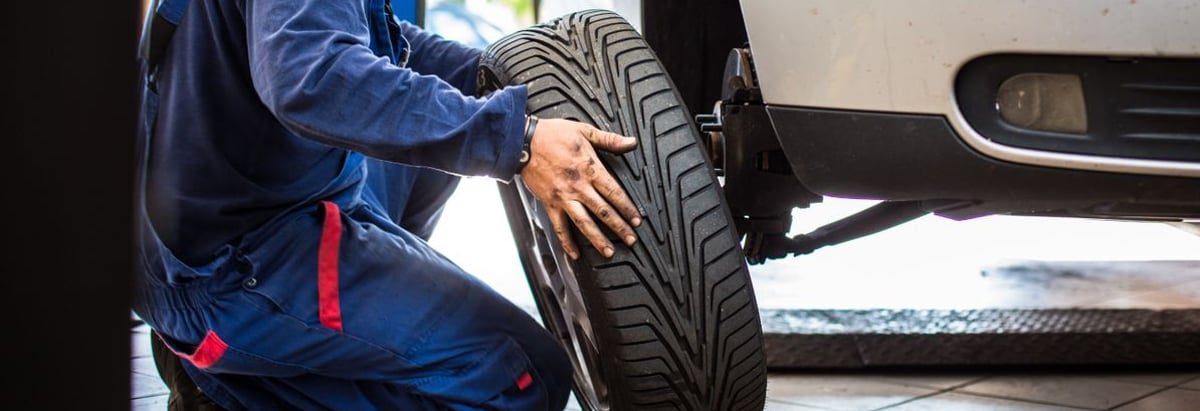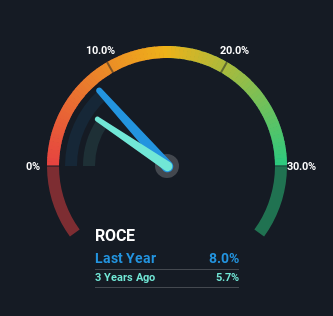- Japan
- /
- Auto Components
- /
- TSE:5101
There Are Reasons To Feel Uneasy About Yokohama Rubber Company's (TSE:5101) Returns On Capital

What trends should we look for it we want to identify stocks that can multiply in value over the long term? Firstly, we'll want to see a proven return on capital employed (ROCE) that is increasing, and secondly, an expanding base of capital employed. Put simply, these types of businesses are compounding machines, meaning they are continually reinvesting their earnings at ever-higher rates of return. In light of that, when we looked at Yokohama Rubber Company (TSE:5101) and its ROCE trend, we weren't exactly thrilled.
Understanding Return On Capital Employed (ROCE)
For those who don't know, ROCE is a measure of a company's yearly pre-tax profit (its return), relative to the capital employed in the business. Analysts use this formula to calculate it for Yokohama Rubber Company:
Return on Capital Employed = Earnings Before Interest and Tax (EBIT) ÷ (Total Assets - Current Liabilities)
0.08 = JP¥100b ÷ (JP¥1.6t - JP¥348b) (Based on the trailing twelve months to December 2023).
Therefore, Yokohama Rubber Company has an ROCE of 8.0%. On its own, that's a low figure but it's around the 7.1% average generated by the Auto Components industry.
View our latest analysis for Yokohama Rubber Company

In the above chart we have measured Yokohama Rubber Company's prior ROCE against its prior performance, but the future is arguably more important. If you'd like, you can check out the forecasts from the analysts covering Yokohama Rubber Company for free.
The Trend Of ROCE
When we looked at the ROCE trend at Yokohama Rubber Company, we didn't gain much confidence. Around five years ago the returns on capital were 10%, but since then they've fallen to 8.0%. Although, given both revenue and the amount of assets employed in the business have increased, it could suggest the company is investing in growth, and the extra capital has led to a short-term reduction in ROCE. If these investments prove successful, this can bode very well for long term stock performance.
The Bottom Line
In summary, despite lower returns in the short term, we're encouraged to see that Yokohama Rubber Company is reinvesting for growth and has higher sales as a result. And the stock has done incredibly well with a 117% return over the last five years, so long term investors are no doubt ecstatic with that result. So while the underlying trends could already be accounted for by investors, we still think this stock is worth looking into further.
If you'd like to know about the risks facing Yokohama Rubber Company, we've discovered 2 warning signs that you should be aware of.
While Yokohama Rubber Company isn't earning the highest return, check out this free list of companies that are earning high returns on equity with solid balance sheets.
New: Manage All Your Stock Portfolios in One Place
We've created the ultimate portfolio companion for stock investors, and it's free.
• Connect an unlimited number of Portfolios and see your total in one currency
• Be alerted to new Warning Signs or Risks via email or mobile
• Track the Fair Value of your stocks
Have feedback on this article? Concerned about the content? Get in touch with us directly. Alternatively, email editorial-team (at) simplywallst.com.
This article by Simply Wall St is general in nature. We provide commentary based on historical data and analyst forecasts only using an unbiased methodology and our articles are not intended to be financial advice. It does not constitute a recommendation to buy or sell any stock, and does not take account of your objectives, or your financial situation. We aim to bring you long-term focused analysis driven by fundamental data. Note that our analysis may not factor in the latest price-sensitive company announcements or qualitative material. Simply Wall St has no position in any stocks mentioned.
About TSE:5101
Yokohama Rubber Company
Engages in the manufacture and sale of tires in Japan and internationally.
Good value with adequate balance sheet.
Similar Companies
Market Insights
Community Narratives



